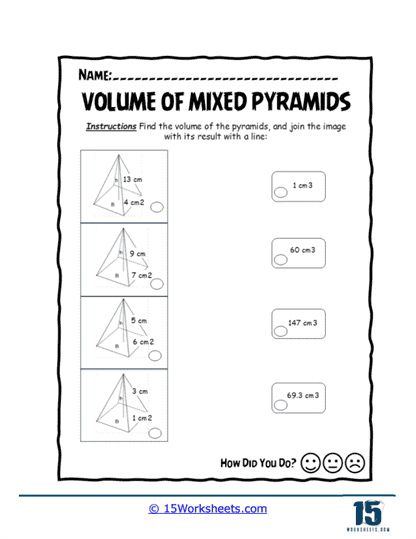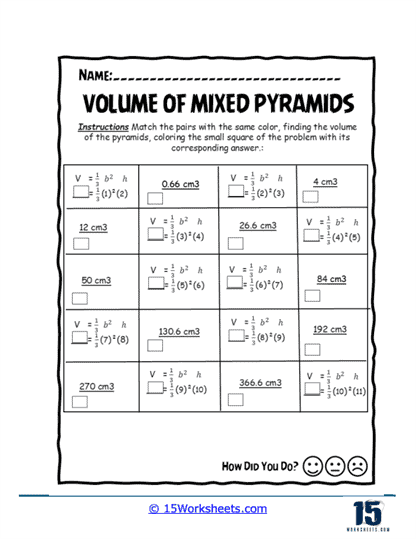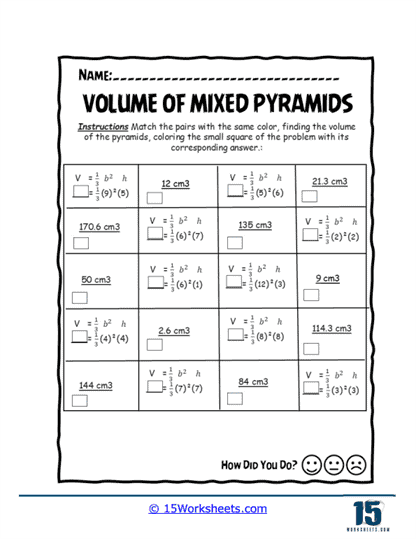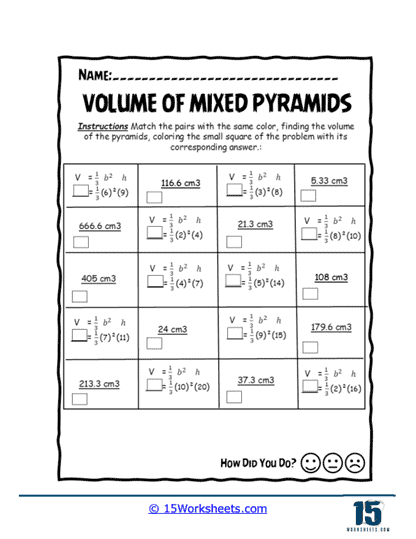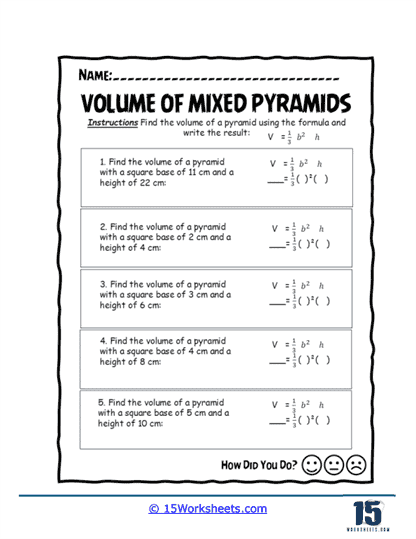Area of Mixed Pyramids Worksheets
About Our Area of Mixed Pyramids Worksheets
This engaging Volume of Mixed Pyramids worksheet collection is designed to help students understand, apply, and master the concept of finding the volume of pyramids. Through a variety of structured exercises, students will practice using the mathematical formula for pyramid volume and develop their problem-solving skills. These worksheets provide an interactive and visually engaging approach to reinforce essential geometry concepts related to three-dimensional shapes.
Ideal for elementary and middle school students, this resource is perfect for classroom activities, homework assignments, or additional practice for mastery. Whether students are new to the concept or need extra reinforcement, these worksheets provide step-by-step guidance to ensure understanding.
Key Features
This worksheet collection is designed to make learning fun, interactive, and effective. Each feature is carefully crafted to help students not only understand the material but also develop confidence in their math skills while keeping them engaged. Let’s take a closer look at the exciting components of these worksheets!
1. Step-by-Step Volume Calculations
Math can feel like a puzzle sometimes, but these worksheets break it down into clear, manageable steps. Students will learn to use the essential formula for finding the volume of a pyramid:
V = ⅓ b2 h
Each problem provides different pyramid measurements, encouraging students to substitute values, follow the formula, and calculate accurately. By working through a variety of examples, they’ll gain a deep understanding of volume calculations and build confidence in applying the formula to real-world situations.
Why this matters – Instead of just memorizing the formula, students will understand when and how to use it, setting them up for success in more advanced math and science courses!
2. Matching and Multiple-Choice Activities
Who doesn’t love a little challenge? These worksheets include engaging matching and multiple-choice exercises that get students thinking critically about volume calculations. Instead of just solving problems, they’ll need to:
- Analyze different pyramid dimensions and recognize which values to use
- Compare answer choices to determine the correct solution
- Strengthen their logical reasoning skills while working through various problem structures
These activities encourage quick thinking and problem-solving-important skills for both math tests and real-world decision-making!
Why this matters – Multiple-choice and matching exercises make learning less intimidating and more interactive, allowing students to test their knowledge in a fun and engaging way.
3. Fill-in-the-Blank and Open-Ended Calculations
Sometimes, the best way to learn is by working through the problem from start to finish. These worksheets include:
- Fill-in-the-blank exercises, where students complete missing parts of equations to reinforce their understanding of how the formula works.
- Open-ended problems, where students must fully calculate the volume of pyramids on their own.
By actively working through each problem, students practice step-by-step reasoning, improve computational accuracy, and develop stronger problem-solving skills.
Why this matters – Students won’t just be guessing answers-they’ll learn to show their work, explain their thought process, and understand the “why” behind the math.
4. Coloring and Interactive Learning
Who says math has to be boring? Some of these worksheets include color-matching activities, where students:
- Solve volume problems and match their answers to corresponding colors
- Color code their responses, creating a visual connection between problems and solutions
- Engage in a more hands-on, artistic approach to math that keeps them motivated and focused
These activities turn number-crunching into a fun challenge, making it easier for students to check their own work and stay engaged in learning.
Why this matters – Blending art with math keeps students interested, focused, and excited-perfect for visual learners or anyone who needs a break from traditional worksheets!
5. Variety of Pyramid Dimensions
Real-world math isn’t one-size-fits-all, and neither are these worksheets! Students will encounter a wide range of pyramid shapes, with varying:
- Base lengths – from small pyramids to larger structures
- Heights – requiring different levels of calculation complexity
- Levels of difficulty – from basic practice problems to more challenging ones for advanced learners
By working with different pyramid dimensions, students will develop a flexible understanding of volume calculations and become more adaptable problem solvers.
Why this matters – Whether students are just starting out or need an extra challenge, these worksheets provide the right level of difficulty for every learner.
Skills Developed
These worksheets don’t just teach students how to punch numbers into a formula-they help build essential life skills that will stick with them long after math class is over! Here’s what students will gain:
Mathematical Computation Skills – No more guessing! Students will master the art of calculating pyramid volume using a clear, step-by-step formula. By practicing different problems, they’ll sharpen their ability to apply the formula accurately every time.
Problem-Solving Abilities – Math isn’t just about getting the right answer-it’s about figuring out how to get there! These worksheets challenge students to think critically, analyze problems, and decide which numbers to plug into the equation. It’s like detective work, but with geometry!
Critical Thinking – When students match problems with their correct solutions or work through tricky volume calculations, they’re actually training their brains to think logically. These exercises help develop skills that go beyond math-like making informed decisions, recognizing patterns, and approaching challenges with confidence.
Attention to Detail – Did you put the right number in the right place? Are your calculations correct? These worksheets encourage students to slow down, check their work, and make sure every step is accurate. Learning to focus on details will help in all areas of life, from school projects to real-world problem-solving!
Independent Learning – Whether working in class or at home, these worksheets encourage students to take charge of their learning. The step-by-step approach builds confidence, so even students who feel nervous about math can tackle these problems with ease.
Real-World Applications
Why do we need to know how to find the volume of a pyramid? Great question! This isn’t just some random math topic-volume calculations are used all the time in real life. Here’s how:
Architecture & Engineering – Ever wonder how architects design pyramids, rooftops, or angled structures? Volume calculations help them figure out how much space a structure takes up and ensure that buildings are stable and efficient. Imagine being the one who designs the next great pyramid-shaped skyscraper!
Construction & Design – Let’s say you’re building a fancy glass pyramid for a shopping mall or need to estimate materials for a roof structure. Construction workers and designers use volume calculations to make sure they order the right amount of materials, saving time and money!
Gaming & 3D Modeling – Love video games? Believe it or not, game developers use volume calculations when designing 3D environments, objects, and characters. Whether it’s designing a pyramid in an adventure game or creating a realistic 3D model of a spaceship, knowing how to measure volume is a must for digital creators.
STEM & Science – From calculating the storage capacity of pyramid-shaped containers to designing spacecraft parts or even studying Egyptian pyramids, understanding volume plays a huge role in science and engineering. Maybe one day, you’ll be using math to design futuristic buildings or even a new space station on Mars!

